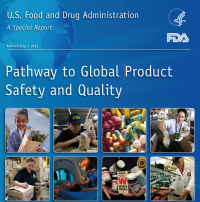The FDA recently released a report on global product safety called the Pathway to Global Product Safety and Quality. This report is even more relevant since the Salmonella Bareilly and Nchanga outbreak linked to imported raw tuna that has sickened at least 258 people in 24 states and D.C.
The FDA is charged with making sure that foods imported in the United States are safe. The government says that almost 2/3 of the fruits and vegetables we eat, and 80% of the seafood, are imported. The number of imported foods has exploded, from 6 million shipments in 2002 to more than 24,000,000 shipments this year. Those products come from 150 countries, 130,000 importers and 300,000 foreign corporations.
The Food Safety Modernization Act of 2010 (FSMA) gave the FDA more power to implement new strategies to protect the U.S. food supply. The report states, “FDA can only realistically inspect a small percentage (less than 3%) of the enormous volume of food products arriving at U.S. ports of entry, making it crucial that the Agency focus on ensuring that food products meet U.S. standards before they reach the Untied States.”
Chris Waldrop, Director of the Food Policy Institute at the Consumer Federation of America, spoke to Food Poisoning Bulletin about this issue. He said, “the inspection piece of the enforcement component is really important, on both the domestic and imported side.” He added, “the foreign supplier verification program rule of FSMA pushes safety back through the supply chain to make sure the importer is bringing safe food into the U.S.”
The FDA is requiring importers to verify that their suppliers have “adequate preventive controls in place and that the food they ship to the U.S. is otherwise safe. The agency also has the power to establish a third-party program for certifying that foreign food facilities comply with U.S. food safety standards, to require certification as a condition of entry for high risk foods, and to reject entry of food if the foreign facility or country refuses an inspection by FDA or its designee.”
The FDA will inspect at least 600 foreign food processing facilities this year, and then double those numbers every year until 2017.
The report states that four measures will change the approach the government has used in the past to ensure safety of imported foods.
- Assemble global coalitions of regulators around the world.
- Develop a global data information system and network, to proactively share real-time information.
- Expand the FDA’s intelligence gathering capabilities, with an increased focus on risk analytics.
- Allocate agency resources basked on risk.





